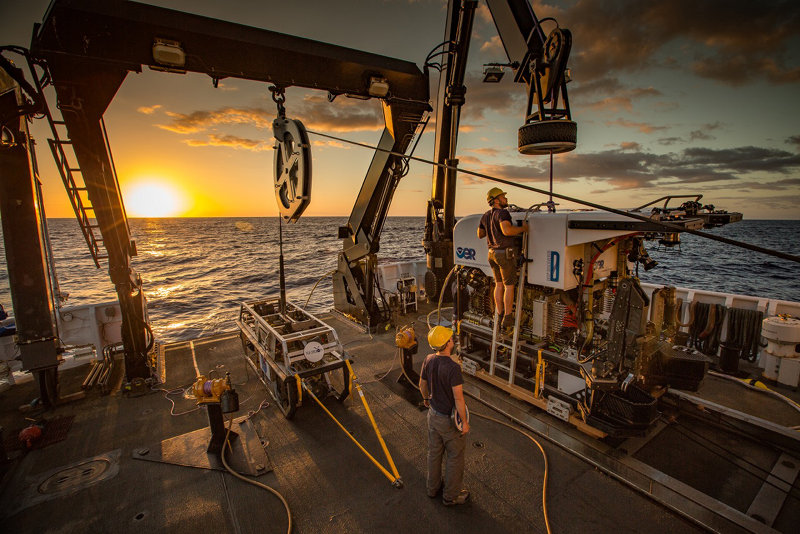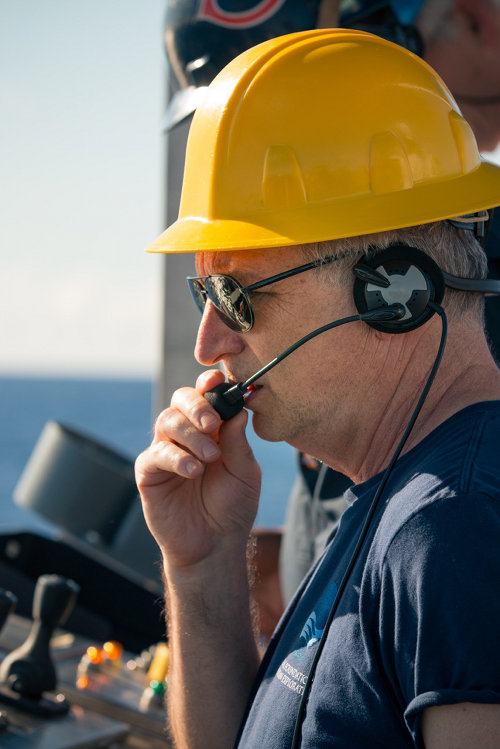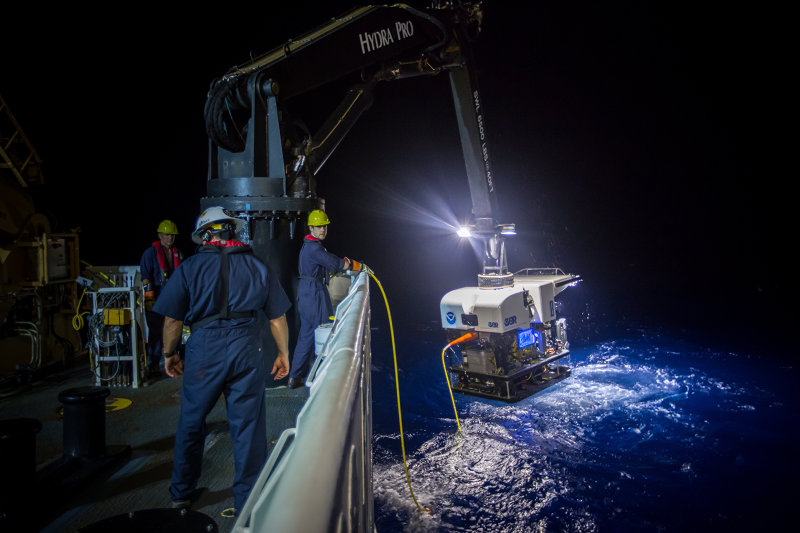
By Jim Newman - Woods Hole Marine Systems, Inc.
May 1, 2016
Hello from NOAA Ship Okeanos Explorer, currently located 100 miles north of the Island of Guam! I’m Jim Newman, the Remotely Operated Vehicle (ROV) Dive Supervisor for Leg 1 of the Deepwater Exploration of the Marianas expedition. This is my fourth trip on the Okeanos Explorer as part of the ROV Engineering Team, but my first in the role of Dive Supervisor.

Remotely operated vehicle Deep Discoverer being prepared for deployment on the Okeanos aft deck. Image courtesy of NOAA Office of Ocean Exploration and Research, 2016 Deepwater Exploration of the Marianas. Download larger version (jpg, 870 KB).
My most daunting responsibility is choreographing the launches and recoveries of the ROV Deep Discoverer (or D2) and the tow sled Seirios. There is a strict protocol to follow, and ideally the process unfolds precisely the same way every time so no one is surprised. In reality, “stuff” happens, and we sometimes have to change plans on the fly, making quick adjustments based on intuition and experience while sticking as close as possible to the routine.
I’ve always been impressed by the others I’ve seen doing it – our other Dive Supervisors always seem unflappable and perfectly on script. By contrast, my first operations felt awkward, and I was often consulting my “cheat sheet” to stay on track and ensure I would not forget any essential steps.

Jim Newman supervising an Okeanos Explorer remotely operated vehicle dive. Image courtesy of NOAA Office of Ocean Exploration and Research, 2016 Deepwater Exploration of the Marianas. Download larger version (jpg, 522 KB).
Once the ship is moving just right relative to the current, wind, and waves, D2 gets craned into the water and drives aft, where it is towed behind the ship while the ship’s officers adjust the lateral (sideways) thrust on the ship and the pilot adjusts D2’s thrust to keep it all gentle. Seirios is then dropped in just astern, under the A-frame.
And that’s just the beginning of a deployment. If something goes slightly weird, the conditions change, or something stops working, we need to adjust this delicate routine before anything goes seriously wrong, and hopefully not use up too much precious dive time in the process.

Remotely operated vehicle Deep Discoverer being recovered. Image courtesy of NOAA Office of Ocean Exploration and Research, 2016 Deepwater Exploration of the Marianas. Download larger version (jpg, 7.7 MB).
Each dive consists of a deployment, a descent to the bottom, an exploration of the seafloor for five to seven hours, an ascent back the surface, and a recovery where the vehicles are brought back aboard. The deployment and recovery are the busy times for the Dive Supervisor, because of the complexity and potential for calamity of those operations and all the people that need to be brought together to complete them.
Right now, about halfway through the expedition, I have supervised 10 dives, and I’m getting the hang of it. The launches and recoveries are getting smoother and I don't need to consult the cheat sheet very often. I hope that by the time this expedition ends, I’ll be able to direct the choreography without using my cheat sheet at all!
I really appreciate the teamwork on Okeanos Explorer. Skilled and dedicated folks from all sorts of backgrounds come together to make these operations happen, and we all share the satisfaction of our successes without any individual monopolizing the limelight. That includes the ship’s officers and crew and the other technical and science people aboard, as well as the ROV team. Okeanos Explorer is a unique ship with a great bunch of people, and I’m proud to be part of it.
I want to especially express appreciation for Karl McLetchie, who has patiently walked me through the ins and outs of being Dive Supervisor during this cruise. My hope is to someday match his level of skill and calm.